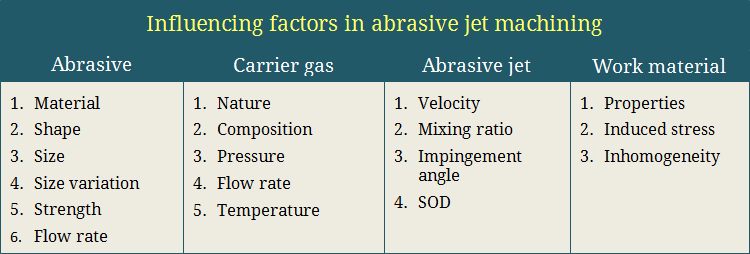Abrasive jet machining (AJM) is one of the advanced machining processes where a high velocity jet of abrasive is used to remove material from work surface by erosion. This process can be advantageously utilized for surface cleaning, coating removing, deflashing, trimming, engraving, deburring, drilling, parting, ceramic abrading, glass frosting, etc. However, for successfully utilizing the process and obtaining desired result, it is indispensably necessary to find out various parameters and their influences on the machining performance. Such parameters and their influences are discussed in the following passages.
List of factors that influence abrasive jet machining performance

Influencing factors related to abrasive
- Type of abrasive—Various abrasive particles have various hardness. Harder abrasives can fetch higher MRR; whereas, softer abrasives tend to crumble when striking hard work surface.
- Shape of abrasive—Irregular shape grits having sharp edges improve MRR as compared to spherical grits.
- Abrasive grain size—Size of indentation created by single grit is proportional to grit diameter. Therefore, larger grits create bigger indentation (thus high MRR); whereas, smaller grits provide smooth surface finish but low MRR.
- Variation in grain size—Commercially available abrasive has diameter in a range (it is not a fixed value). Lesser the variation of diameter within the overall mass, better will be prediction for surface quality and MRR.
- Presence of impurity—Presence of tiny metallic particles within abrasive can cause blockage in pipeline and thus variation in flow rate can be observed.
Influencing factors related to carrier gas
- Gas pressure—Pressure of carrier gas after mixing with abrasives is converted into kinetic energy. Thus higher gas pressure indicates high jet velocity and thus higher MRR.
- Gas flow rate—Gas flow rate basically influences mixing ratio and MRR becomes maximum at an optimum value of mixing ratio.
- Moisture content—Since very high pressure is utilized, so presence of steam within the gas may convert into water particles, which can grab abrasives and agglomerate into a large particles. This can block pipelines, vary jet velocity and also erode nozzle at a faster rate.
Influencing factors related to nozzle
- Inner diameter—Higher nozzle inner diameter indicates lower jet velocity for the same gas pressure and mixing ratio. So improper jet diameter can hamper MRR as well as surface quality.
- Worn out nozzle—Nozzle diameter increases due to wear.
- Nozzle material—Life of the nozzle (wear rate) greatly depends on nozzle material.
Influencing factors related to abrasive jet
- Jet velocity—Higher jet velocity can erode material at a faster rate but it requires high carrier gas pressure. So the machine set-up should have to be capable of withstanding such high pressure without leakage.
- Jet diameter—It is actually based on nozzle inner diameter and stand-off distance. Higher jet diameter can erode material from a wider zone; however, accuracy may degrade as abrasives present at the jet center will get less chance to come out after impact and thus collide with the fresh jet.
Influencing factors related to process parameters
- Mixing ratio—It greatly influences MRR and penetration depth (surface finish). An optimum level provides better result.
- Abrasive flow rate—It is also another important factor as MRR is proportional to the mass flow rate of abrasive.
- Stand-off distance (SOD)—With increase in SOD, jet diameter also increases because of spreading. Thus higher SOD results in low velocity but wider jet. Whereas, small SOD provides insufficient passage for used grits to leave machining zone.
- Impingement angle—It is the operating angle between work surface and jet diameter. Usually it is kept between 60º – 90º; higher value produces deeper cut. Numerous researches indicate that MRR becomes maximum at an impingement angle of 70º – 90º based on work material and many other parameters.
Influencing factors related to work material
- Poor working surface condition—If surface roughness is high then accuracy of cut may hamper. Similarly highly finished surface reduces MRR because of possible abrasive bounce back effect.
- Inhomogeneity in material properties—It may result in inaccuracy in machining.
- Stress concentration—It can reduce MRR by reducing erosion rate.
Responses for measuring performance (output parameters)
Performance of abrasive jet machining is commonly determined by analyzing following three factors. Material removal rate basically determines the productivity; while surface finish determines the applicability. Nozzle life or nozzle wear rate is also one important response to take care as a worn out nozzle can degrade surface quality if not replaced timely. It also contributes to the total machining cost as nozzle life is short and it takes considerable amount of time for changing. Also nozzles are costlier.
- Material Removal Rate (MRR)
- Surface finish
- Nozzle life
References
- Paper: I. Finnie (1972); Some observations on the erosion of ductile metals; Wear; Vol. 19 (1), pp. 81-90.
- Paper: M. W. Chastagner and A. J. Shih, Abrasive Jet Machining for Edge Generation, Transactions of NAMRI/SME, Volume 35, 2007.
- Book: Nonconventional Machining by P. K. Mishra (Narosa Publishing House).